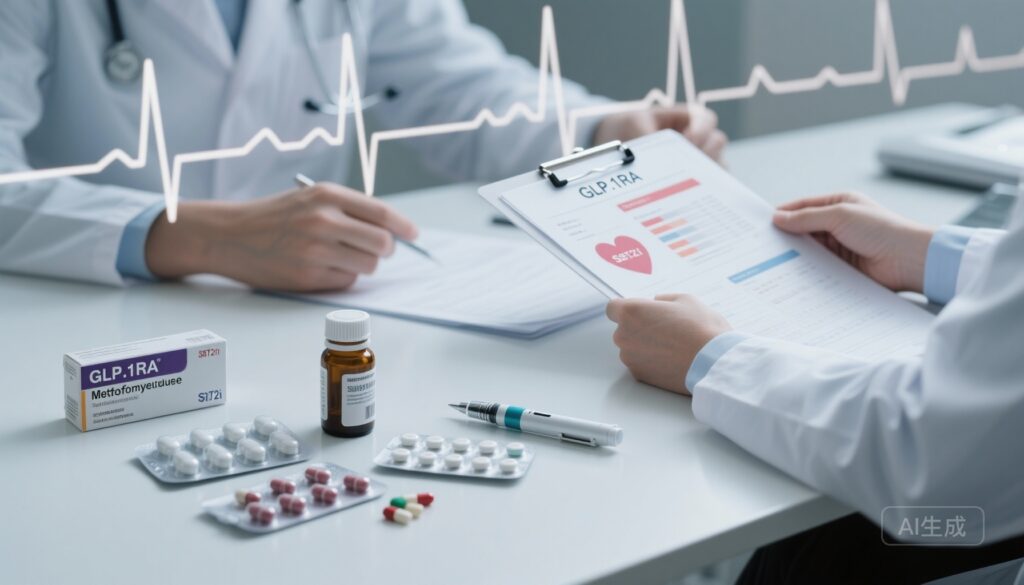Highlight
– In an emulated 4‑arm trial of 241,981 adults with type 2 diabetes (T2D), sustained exposure to glucagon‑like peptide‑1 receptor agonists (GLP‑1RAs) was associated with the lowest 2.5‑year risk of major adverse cardiovascular events (MACE), followed by sodium‑glucose cotransporter‑2 inhibitors (SGLT2is), sulfonylureas, and dipeptidyl peptidase‑4 inhibitors (DPP4is).
– Absolute 2.5‑year risk differences were clinically meaningful: DPP4i versus sulfonylurea, 1.9% (95% CI 1.1%–2.7%); SGLT2i versus GLP‑1RA, 1.5% (95% CI 1.1%–1.9%). The GLP‑1RA advantage over SGLT2is was most evident in patients ≥65 years, with ASCVD or heart failure (HF), or with mild–moderate kidney impairment; it was not observed in those <50 years.
Background
Cardiovascular disease remains the leading cause of morbidity and mortality in people with type 2 diabetes. Over the last decade, cardiovascular outcome trials (CVOTs) have shown that certain antihyperglycemic drug classes, notably GLP‑1RAs and SGLT2is, reduce cardiovascular events beyond glucose lowering. However, direct head‑to‑head randomized comparisons across major classes are scarce, and observational studies have often been limited by inadequate confounding control. Clinicians need comparative effectiveness evidence that reflects routine care and patient heterogeneity to guide individualized drug selection.
Study design
This comparative‑effectiveness analysis (Neugebauer et al., JAMA Netw Open 2025) used administrative and electronic health record data from six large US health delivery systems to identify adults with T2D who initiated a new glucose‑lowering medication in one of four classes—sulfonylureas, DPP4is, SGLT2is, or GLP‑1RAs—between January 1, 2014 and December 31, 2021. The analytic cohort for an emulated 4‑arm trial comprised 241,981 patients (mean age 57.2 years, 54.3% male). Exposure was defined by prescription fills and sustained treatment; primary outcome was MACE (nonfatal myocardial infarction, nonfatal stroke, or cardiovascular death) over 2.5 years.
Analyses applied modern causal inference methods (targeted learning within a trial emulation framework) and machine‑learning based outcome and propensity models to adjust for confounding and estimate comparative cumulative incidence and risk differences. Pre‑specified subgroup analyses included baseline atherosclerotic cardiovascular disease (ASCVD), heart failure (HF), age bands, and kidney function.
Key findings
The study included 296,676 adults overall, with the 4‑arm emulated trial cohort of 241,981 used for primary comparisons. After adjustment, the hierarchy of 2.5‑year MACE risk was: GLP‑1RAs (lowest), SGLT2is, sulfonylureas, and DPP4is (highest).
Two clinically important adjusted 2.5‑year absolute risk differences reported:
- DPP4is vs sulfonylureas: 1.9% higher cumulative MACE risk with DPP4is (95% CI, 1.1%–2.7%).
- SGLT2is vs GLP‑1RAs: 1.5% higher cumulative MACE risk with SGLT2is (95% CI, 1.1%–1.9%).
Subgroup findings:
- The direction of class differences was broadly consistent when stratified by baseline ASCVD, but absolute differences were typically much smaller among patients without established ASCVD.
- The benefit of GLP‑1RAs over SGLT2is for reducing MACE was most pronounced in patients with baseline ASCVD or HF, those aged ≥65 years, and those with mild to moderate kidney impairment. No benefit of GLP‑1RAs over SGLT2is was seen in patients younger than 50 years.
Safety and collateral outcomes were not detailed in the study summary; however, known class effects remain relevant to clinical choice (see Expert Commentary).
Clinical interpretation and implications
These results align with randomized CVOT data indicating cardiovascular benefit with both GLP‑1RAs and SGLT2is, but they extend prior knowledge by providing contemporaneous head‑to‑head comparative effectiveness across four widely used classes in routine care. Key practical implications:
- For patients with established ASCVD or multiple atherosclerotic risk factors, GLP‑1RAs may offer the greatest reduction in atherosclerotic MACE and should be considered when feasible and consistent with patient values, tolerability, and cost considerations.
- SGLT2is retain important advantages, particularly for prevention of heart failure hospitalization and for renal protection, and remain first‑line add‑on agents for many patients—especially those with HF or progressive chronic kidney disease.
- Sulfonylureas demonstrated intermediate MACE risk in this analysis but carry higher hypoglycemia risk and weight gain; they may remain appropriate when affordability is the paramount issue and hypoglycemia risk is manageable.
- DPP4is had the highest adjusted MACE risk in this comparison; they remain neutral on MACE in randomized trials but may be selected for older patients at low cardiovascular risk or when oral therapy with a favorable tolerability profile is preferred.
Biological plausibility and mechanism
GLP‑1RAs exert multiple effects—weight loss, modest blood pressure and lipid improvements, anti‑inflammatory and anti‑atherosclerotic actions—that plausibly translate into reduced atherothrombotic events. SGLT2is reduce intravascular volume and cardiac preload, modulate myocardial energetics, and confer renal protection; these mechanisms are particularly effective for reducing HF events and slowing kidney disease progression. The observed relative advantage of GLP‑1RAs for MACE (atherothrombotic composite) in patients with established ASCVD is biologically plausible given these divergent mechanistic profiles.
Strengths and limitations
Strengths:
- Very large, multisite US cohort with diverse clinical settings and follow‑up.
- Application of modern causal inference (targeted learning) and machine‑learning methods to emulate a randomized trial and adjust for measured confounding.
- Pre‑specified subgroup analyses that inform individualized decision‑making.
Limitations:
- Observational design—even with advanced adjustment—cannot fully eliminate residual confounding by unmeasured factors (e.g., socioeconomic variables not captured, clinician prescribing preferences, lifestyle differences, or unmeasured severity measures).
- Exposure was defined by prescription fills; actual medication adherence and persistence may differ from filled prescriptions.
- Outcome ascertainment relied on routine data and coding; although major events like MI and stroke are generally well captured, misclassification is possible.
- Generalizability to settings outside integrated US delivery systems or to populations with different access, medication costs, or prescribing patterns may be limited.
Expert commentary and guideline context
Major professional guidelines (e.g., American Diabetes Association Standards of Care) already recommend consideration of GLP‑1RAs or SGLT2is for people with T2D and established ASCVD, HF, or CKD, independent of baseline HbA1c when cardiovascular or renal risk reduction is a priority. This comparative‑effectiveness work supports those recommendations and provides more granular evidence favoring GLP‑1RAs for atherosclerotic MACE prevention in higher‑risk subgroups. Clinicians should integrate these findings with individual patient factors—age, comorbidities, kidney function, side‑effect profiles, patient preferences, and access/cost constraints.
Practical considerations for clinicians
- Assess cardiovascular and renal risk profile early in treatment planning for patients with T2D; for patients with ASCVD or multiple risk factors, prioritize GLP‑1RA or SGLT2i therapy where possible.
- When choosing between GLP‑1RA and SGLT2i, consider the dominant clinical goal: GLP‑1RAs for atherothrombotic risk reduction and weight management; SGLT2is for HF risk reduction and renal protection.
- Discuss adverse effects: GLP‑1RAs commonly cause gastrointestinal symptoms and are injectables (though oral semaglutide is available); SGLT2is can increase genital infections and cause volume depletion and euglycemic ketoacidosis (rare), but also reduce HF hospitalizations and slow CKD progression.
- Cost and coverage limitations remain major barriers to broad uptake of GLP‑1RAs and SGLT2is; sulfonylureas and DPP4is may be pragmatic alternatives when affordability and pill burden are critical considerations.
Conclusions and research gaps
This large comparative‑effectiveness study indicates that sustained GLP‑1RA treatment is associated with the lowest 2.5‑year MACE risk among four commonly used glucose‑lowering classes, with SGLT2is providing the next greatest protection. The magnitude of benefit varies by age, baseline ASCVD, HF, and kidney function—supporting individualized prescribing. Future research should aim to: (1) prospectively evaluate head‑to‑head cardiovascular outcomes in randomized trials or pragmatic trials, (2) clarify long‑term comparative safety and noncardiovascular benefits, and (3) address barriers to equitable access to GLP‑1RAs and SGLT2is.
Funding and clinicaltrials.gov
Funding and trial registration details should be confirmed in the original publication: Neugebauer R, An J, Dombrowski SK, et al. Glucose‑Lowering Medication Classes and Cardiovascular Outcomes in Patients With Type 2 Diabetes. JAMA Netw Open. 2025;8(10):e2536100. DOI: 10.1001/jamanetworkopen.2025.36100.
Selected references
1. Neugebauer R, An J, Dombrowski SK, et al. Glucose‑Lowering Medication Classes and Cardiovascular Outcomes in Patients With Type 2 Diabetes. JAMA Netw Open. 2025;8(10):e2536100. doi:10.1001/jamanetworkopen.2025.36100.
2. Zinman B, Wanner C, Lachin JM, et al.; EMPA‑REG OUTCOME Investigators. Empagliflozin, cardiovascular outcomes, and mortality in type 2 diabetes. N Engl J Med. 2015;373(22):2117‑2128.
3. Marso SP, Daniels GH, Brown‑Frandsen K, et al.; LEADER Steering Committee. Liraglutide and cardiovascular outcomes in type 2 diabetes. N Engl J Med. 2016;375(4):311‑322.
4. Neal B, Perkovic V, Mahaffey KW, et al.; CANVAS Program Collaborative Group. Canagliflozin and cardiovascular and renal events in type 2 diabetes. N Engl J Med. 2017;377(7):644‑657.
5. Gerstein HC, Colhoun HM, Dagenais GR, et al.; REWIND Study Investigators. Dulaglutide and cardiovascular outcomes in type 2 diabetes (REWIND). Lancet. 2019;394(10193):121‑130.
6. Scirica BM, Bhatt DL, Braunwald E, et al.; SAVOR‑TIMI 53 Steering Committee. Saxagliptin and cardiovascular outcomes in patients with type 2 diabetes mellitus. N Engl J Med. 2013;369(14):1317‑1326.
7. American Diabetes Association. 2024 Standards of Care in Diabetes—Cardiovascular disease and risk management. Diabetes Care. 2024;47(Suppl 1):Sxxxx–Sxxxx.
Author note
This article synthesizes the reported findings of Neugebauer et al. (JAMA Netw Open 2025) and places them in the context of randomized CV outcome trials and guideline recommendations. Clinicians should consult the full original report for full methodological details, sensitivity analyses, and dataset‑specific information prior to altering practice.



